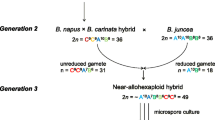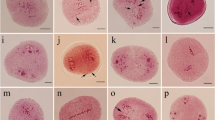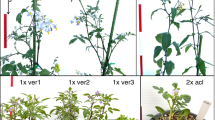Abstract
Tetrasomic plants with two additional small chromosomes were identified, with a frequency about 2.5%, in the trisomic pea line TRUST-R, which normally contains one extra chromosome covering a sporophyte lethal in the regular chromosome set. As compared to trisomics, tetrasomics exhibited an enhanced expression of the traits resulting from extra chromosome addition: slow growth, enlarged bracts, shortened peduncles, wavy leaflets and stipulae. They were almost sterile, their pollen contained a variable proportion of empty grains and some anomalously large, small or deformed grains. In metaphase I, two extra chromosomes did not form a stable bivalent and only in some cases were situated close to each other. In anaphase I, the extra chromosomes migrated independently to either pole or retarded in the equatorial plain, the same was observed for chromatids in anaphase II. This retardation resulted in anomalous cytokinesis, so that triads, dyads and half-divided or non-divided monads appeared. The retarded extra chromosomes may form small extra nuclei either included into one of the microspores or forming a separate miniature cell; in this way tetrasomics may eliminate extra chromosomes. One of the tetrasomics analysed formed an exceptionally high proportion of microspore pentads. In the regluar TRUST-R trisomics, the sole extra chromosome retarded in the equatorial plain in anaphases I and II. The retardation in anaphase II often makes cytokinesis in trisomics (in general more regular than in tetrasomic) to proceed in two steps: at first cell wall formation separates a pollen mother cell into two dyads and then each of them into two microspores.










Similar content being viewed by others
References
Abe K, Osakabe K, Nakayama S, Endo M, Tagiri A, Todoriki S, Ichikawa Y, Toki S (2005) Arabidopsis RAD51C gene is important for homologous recombination in meiosis and mitosis. Plant Physiol 139:896–908. doi:10.1104/pp.105.065243
Berdnikov VA, Gorel FL, Temnykh SV (1993) A more precise location of the breakpoints in Hammarlund’s K-like. Pisum Genet 25:18–21
Berdnikov VA, Gorel FL, Kosterin OE (2000) New mutations in the linkage group V have provided stable trisomic lines of pea. Pisum Genet 32:13–15
Berdnikov VA, Gorel FL, Kosterin OE, Bogdanova VS (2003) Tertiary trisomics in the garden pea as a model of B chromosome evolution in plants. Heredity 91:577–583. doi:10.1038/sj.hdy.6800357
Bogdanova VS, Berdnikov VA (2000) A study of potential ability for cross-pollination in pea originating from different parts of the world. Pisum Genet 32:16–17
Loenning W-E (1984) Cross fertilization in peas under different ecological conditions. Pisum Newsl 16:38–40
Pellew C (1940) Genetical studies of the first reciprocal translocation found in Pisum sativum. J Genet 39:362–390
Popova IS (1975) Cytogenetic studies. In: Khvostova VV (ed) Genetika i selektsiya gorokha [Genetics and selection of pea]. Nauka, Novosibirsk, pp 106–141 in Russian
Yu W, Han F, Birchler JA (2007) Engeneering microchromosomes in plants. Curr Opin Biotechnol 18:425–431
Acknowledgments
This work was supported by the project of the Russian Academy of Sciences ‘Biosphere origin and evolution’ and the grant 07-04-00111-a of the Russian Foundation for Fundamental Research. Microphotography was carried out using the Collective Microscopy Centre at the Institute of Cytology and Genetics, Novosibirsk.
Author information
Authors and Affiliations
Corresponding author
Rights and permissions
About this article
Cite this article
Kosterin, O.E., Galieva, E.R. & Bogdanova, V.S. The first record of tetrasomy in pea (Pisum sativum L.). Euphytica 166, 109–121 (2009). https://doi.org/10.1007/s10681-008-9843-x
Received:
Accepted:
Published:
Issue Date:
DOI: https://doi.org/10.1007/s10681-008-9843-x




